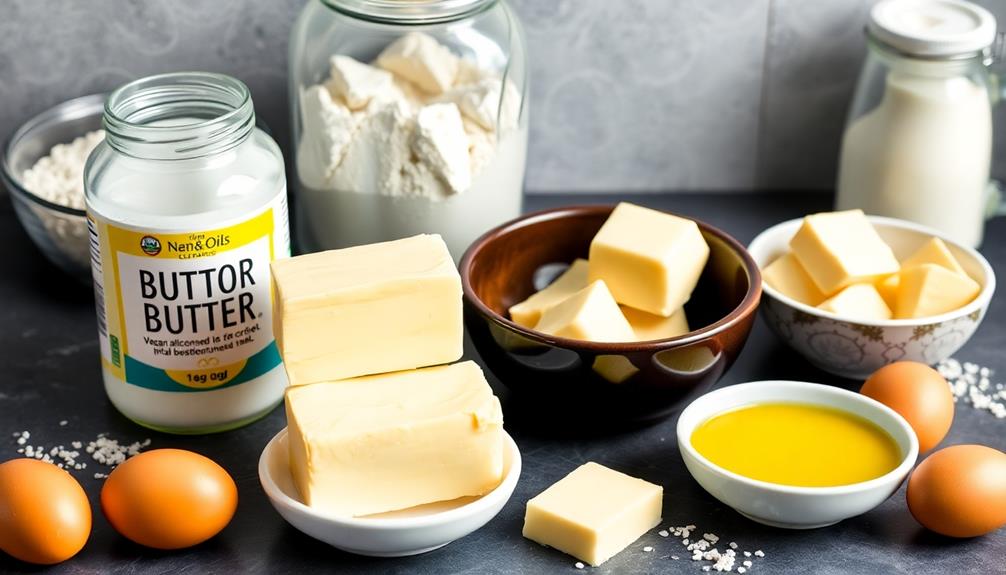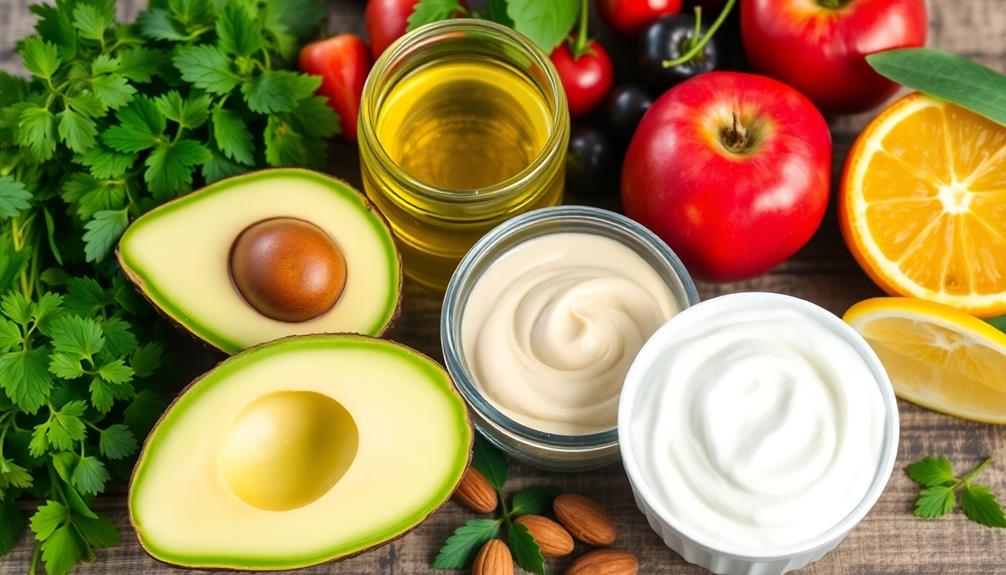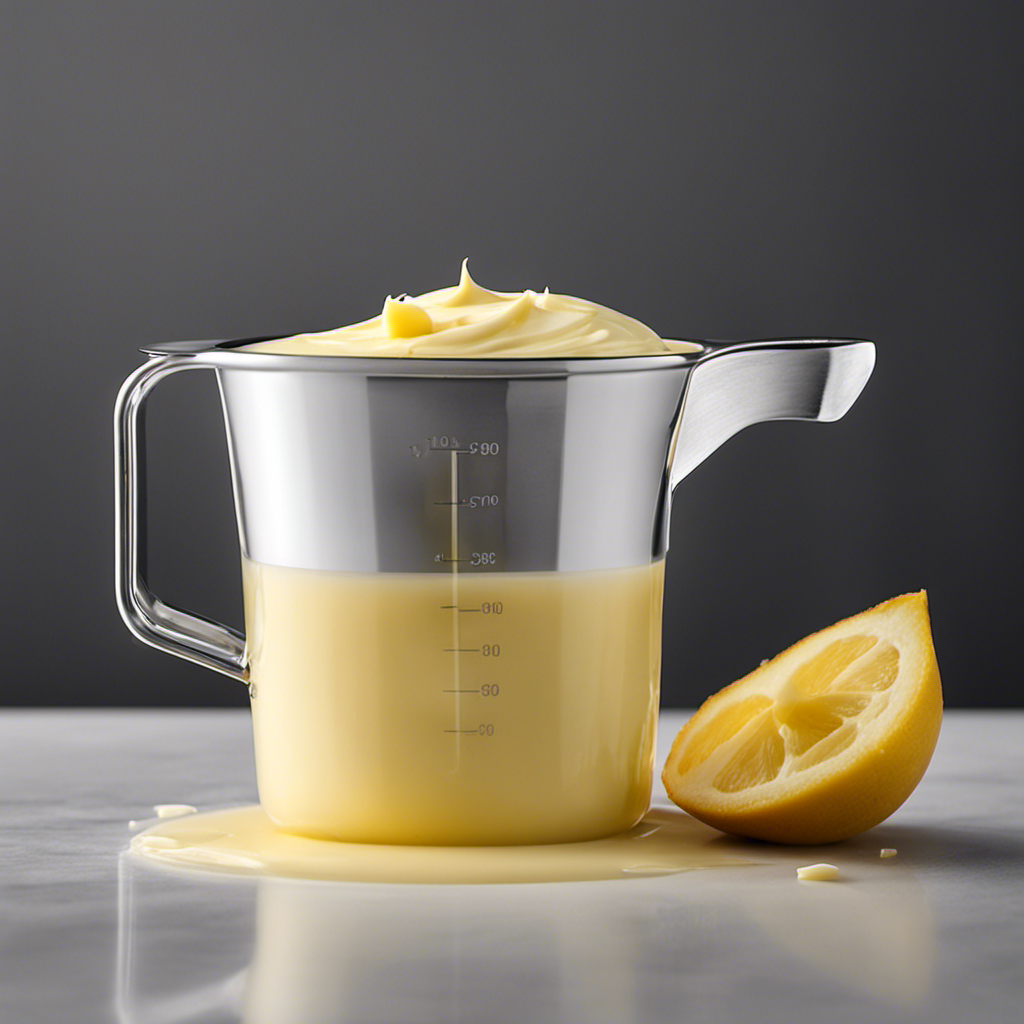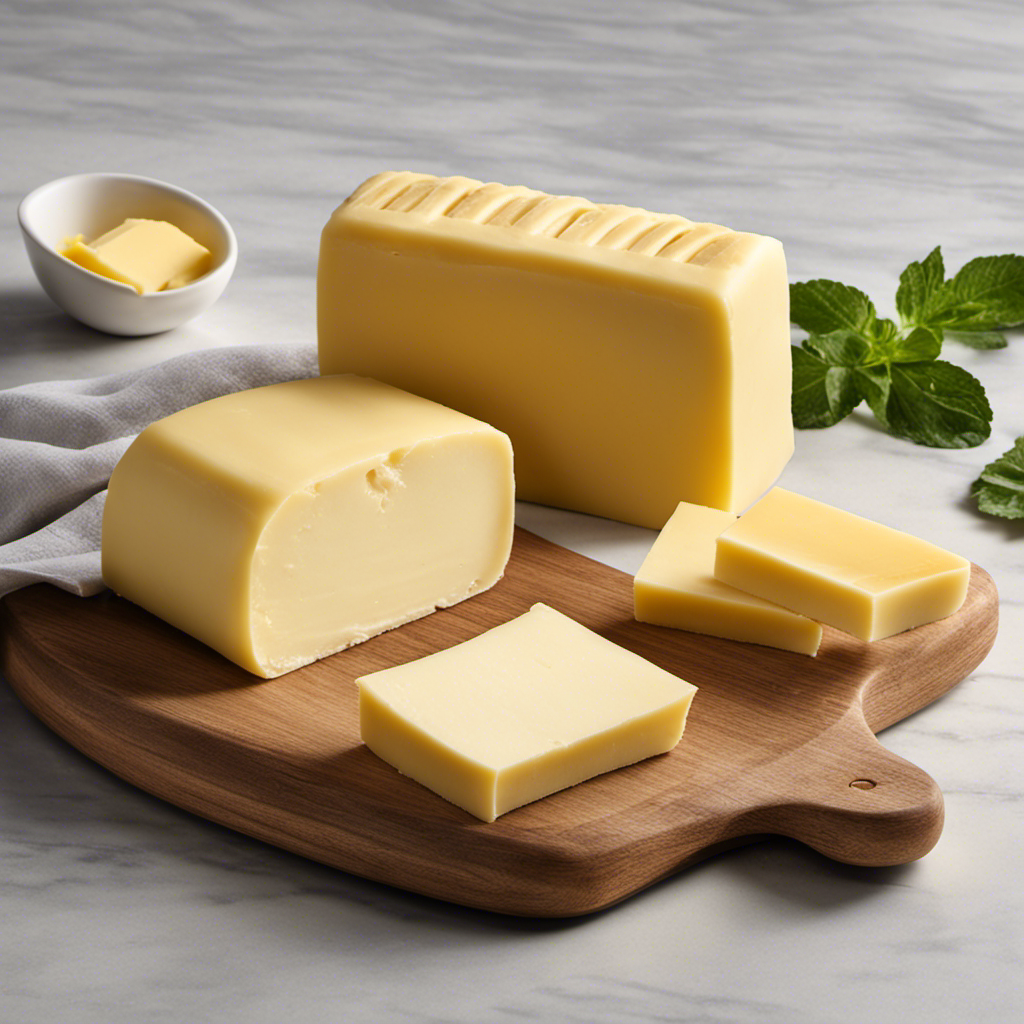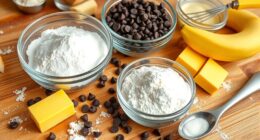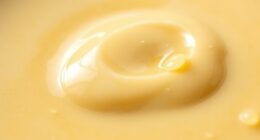You can elevate your baking with various butter alternatives suited to your needs. Coconut oil offers a creamy texture with a hint of coconut flavor, while unsweetened applesauce adds moisture and subtle sweetness. Avocado provides healthy fats, perfect for brownies or muffins, and silken tofu brings creaminess to dense goods. Greek yogurt reduces fat yet keeps your treats rich, and margarine is a classic option with a similar texture. Ghee offers a unique richness, whereas nut butters enhance flavor and nutritional value. Shortening brings tenderness to pastries. Explore these options for delightful results and discover even more alternatives available!
Key Takeaways
- Coconut oil is a versatile alternative that adds creaminess and a subtle coconut flavor, usable in a 1:1 ratio.
- Unsweetened applesauce enhances moisture and sweetness; replace half the butter for a healthier option.
- Greek yogurt reduces fat while maintaining richness; substitute half the butter for optimal results and added protein.
- Nut butters provide healthy fats and protein; replace half the butter in cookies and muffins for improved texture.
- Margarine and ghee are solid options, with ghee offering a lactose-free richness, both substitutable in a 1:1 ratio.
Coconut Oil
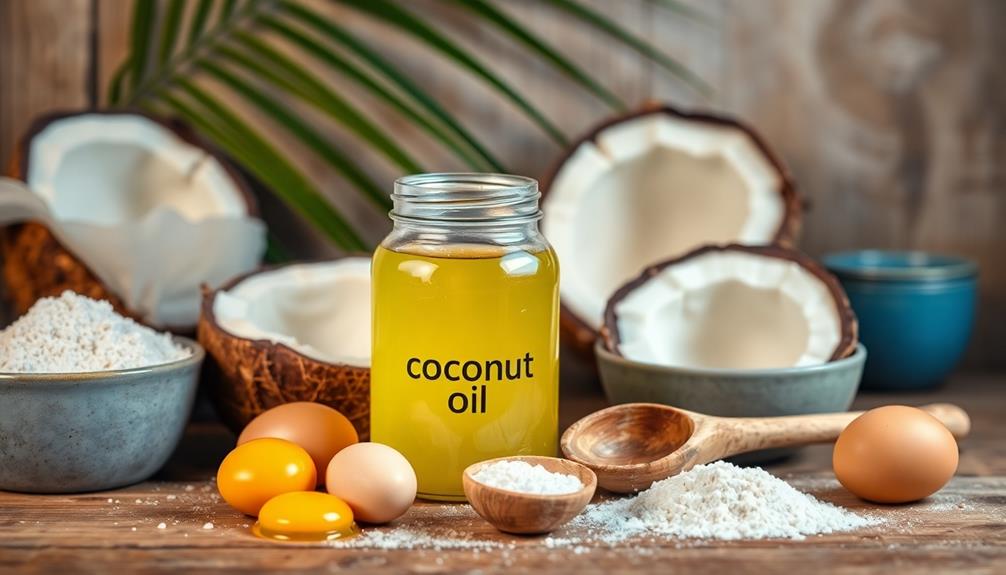
Coconut oil is a fantastic butter alternative that many bakers love. It's versatile, with a creamy texture that works well in various recipes. When you substitute coconut oil for butter, you'll find that it adds a subtle coconut flavor, enhancing the overall taste of your baked goods.
Additionally, coconut oil contains medium-chain triglycerides (MCTs), which may offer various health benefits, making it a great choice for those looking to improve their diet rich in antioxidants. You can use it in a 1:1 ratio for most recipes, but keep in mind that coconut oil solidifies at cooler temperatures. If your recipe calls for melted butter, simply melt the coconut oil before mixing it in. This oil is particularly great for vegan baking, as it provides the richness that butter typically adds.
Another benefit is its health properties. Coconut oil contains medium-chain triglycerides (MCTs), which may offer various health benefits. Plus, it's dairy-free, making it a suitable option for those with lactose intolerance or dairy allergies.
When using coconut oil, opt for virgin or extra-virgin varieties for the best flavor and nutritional benefits. Just remember, while coconut oil can enhance many recipes, it mightn't be the best fit for every baked good, especially where a neutral flavor is desired.
Applesauce
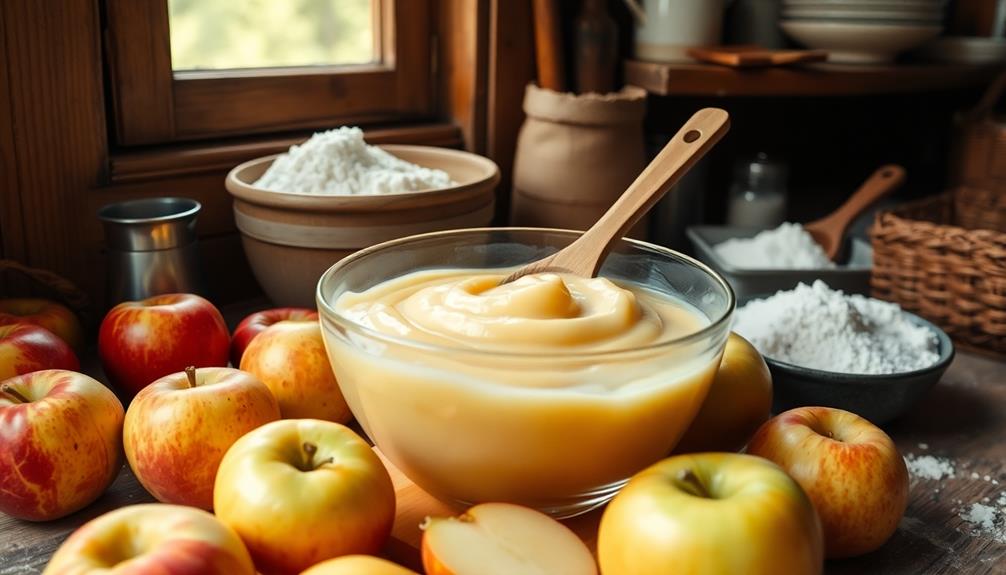
When you're looking for a butter alternative in baking, applesauce is an excellent choice that adds moisture and sweetness to your recipes. It's particularly useful in cakes, muffins, and brownies, where you want to maintain a tender texture without the added fat. Simply replace half of the butter with unsweetened applesauce for a healthier option that still delivers on flavor.
Additionally, incorporating this fruit puree can enhance the nutritional profile of your baked goods, providing benefits similar to those found in baked kale due to its fiber and vitamin content.
Using applesauce not only cuts calories but also enhances the nutritional profile of your baked goods. It's packed with fiber, vitamins, and minerals, making it a smart swap. Keep in mind that applesauce adds natural sweetness, so you might want to reduce the sugar in your recipe slightly to balance the flavors.
One thing to watch out for is the consistency of your batter. Since applesauce is liquid, it can make your baked goods denser if you use too much. Experiment with different ratios to find what works best for your specific recipe.
Don't hesitate to get creative, as applesauce can also pair beautifully with spices like cinnamon or nutmeg. So next time you bake, grab that jar of applesauce and enjoy the delicious results!
Avocado
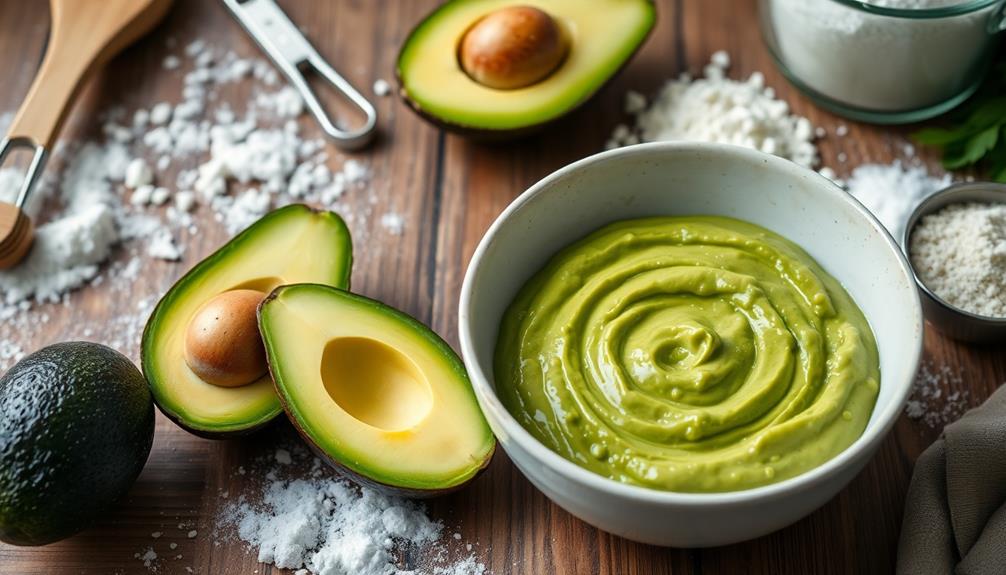
If you're looking for a creamy, nutritious butter alternative in baking, avocado is a fantastic option. Its rich texture and healthy fats make it perfect for adding moisture to your recipes. When using avocado, you can replace butter on a one-to-one basis, ensuring your baked goods remain deliciously satisfying.
Simply mash ripe avocados until smooth, and mix them into your batter or dough. You'll find that avocado adds a subtle flavor, enhancing your treats without overpowering them. It works particularly well in brownies, muffins, and cakes, providing a delightful richness.
Another benefit of using avocado is its nutritional profile. Packed with vitamins, minerals, and healthy monounsaturated fats, it adds a boost of goodness to your baked creations. You'll also appreciate that it can help reduce cholesterol levels.
Keep in mind that the color of your baked goods may be affected; they might take on a greenish hue. But don't worry, they'll still taste amazing!
Nut Butters
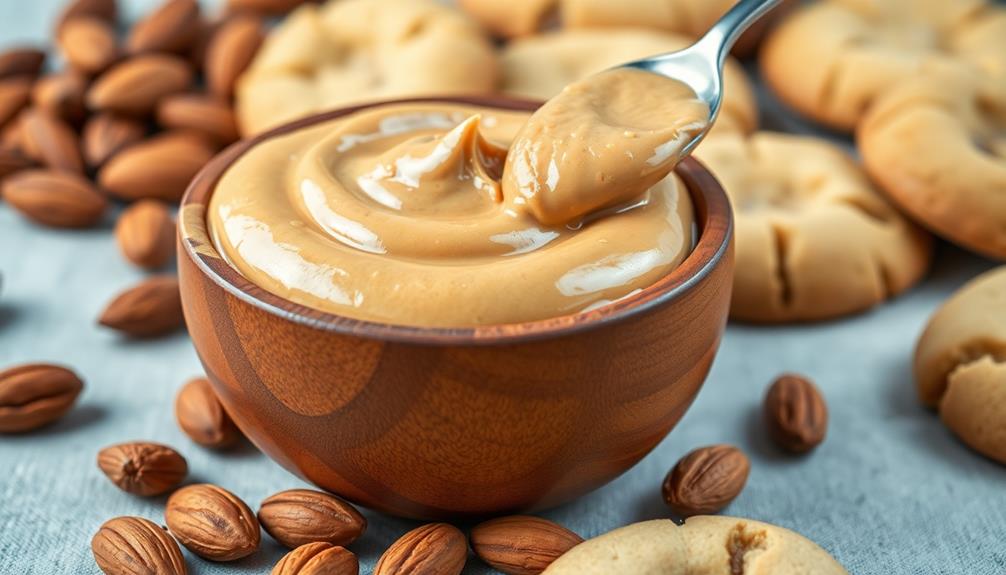
Nut butters pack a powerful nutritional punch, offering healthy fats and protein that can enhance your baked goods.
You'll find that they work wonderfully in recipes like cookies and brownies, adding rich flavor and moisture.
Let's explore how to incorporate nut butters effectively in your baking.
Nutritional Benefits of Nut Butters
Incorporating nut butters into your baking not only enhances flavor but also adds a wealth of nutritional benefits. These creamy spreads are packed with healthy fats that can support heart health and provide a satisfying source of energy. Additionally, certain nut butters may help reduce inflammation in the body, much like turmeric's potent relief for joint pain.
When you choose nut butters like almond, cashew, or peanut, you're also getting a good dose of protein, making your baked goods more filling. Nut butters are rich in essential vitamins and minerals, such as vitamin E, magnesium, and potassium. These nutrients help promote overall health and can aid in muscle recovery after workouts.
Additionally, the fiber content in nut butters can contribute to better digestion and help keep you feeling full longer. Another significant benefit is the presence of antioxidants in many nut butters, which can help reduce inflammation and combat oxidative stress in your body.
Best Uses in Baking
Using nut butters in your baking can transform ordinary recipes into extraordinary treats. Whether you're whipping up cookies, cakes, or muffins, incorporating nut butters like almond, peanut, or cashew can add rich flavors and creamy textures.
For cookies, try replacing half the butter with nut butter; it'll give your cookies a chewy consistency and nutty taste that everyone will love.
In cakes, you can substitute nut butter for a portion of the fat for added moisture and flavor. This works particularly well in chocolate cakes, where the nutty undertones can enhance the chocolate. Just remember to adjust the sugar, as some nut butters can be slightly sweet.
Muffins are another perfect canvas for nut butters. They can replace up to 100% of the fat, resulting in moist, hearty muffins that are packed with protein. You can also swirl nut butter into the batter for a delightful surprise in each bite.
When baking bread, use nut butter to enrich the dough, improving texture and taste. Just keep in mind that nut butters can change the final product's density, so experiment until you find the perfect balance.
Enjoy the nutty goodness!
Vegetable Shortening
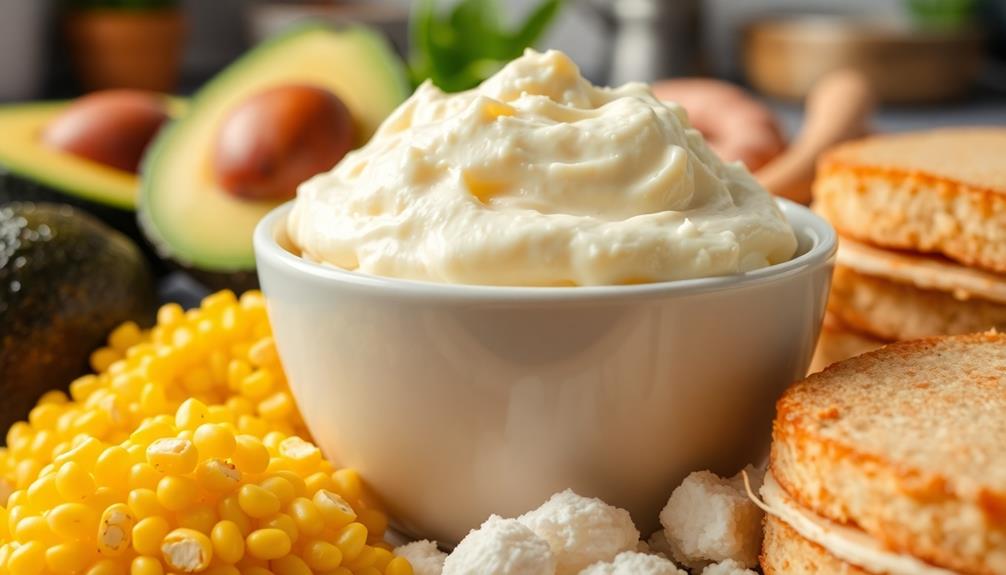
When you use vegetable shortening in your baking, you'll notice a unique texture and consistency that can enhance your treats.
However, it's important to weigh the health implications of this ingredient compared to butter.
Let's explore how vegetable shortening can affect both your baked goods and your well-being.
Texture and Consistency
Achieving the right texture and consistency in baked goods often hinges on the choice of fat, and vegetable shortening is a popular option for those seeking a tender crumb.
It has a high fat content and can create a wonderfully light and airy texture in your recipes. Unlike butter, which can add moisture, shortening helps to reduce moisture loss during baking, making your treats softer and more tender.
When you choose vegetable shortening, you can expect:
- Flakiness: It promotes layers in pastries, giving you that desirable flaky texture.
- Stability: Shortening maintains its shape at room temperature, ideal for cookies and frostings.
- Creaminess: It blends easily into batters, creating a smooth consistency for cakes and brownies.
- Neutral Flavor: It won't overpower your other ingredients, allowing the true flavors to shine.
Health Considerations
While vegetable shortening can be a versatile baking ingredient, it's important to evaluate its health implications. Many types of shortening contain partially hydrogenated oils, which can increase trans fat levels. These trans fats can raise your bad cholesterol (LDL) and lower your good cholesterol (HDL), potentially leading to heart disease.
When you're considering using shortening, check the label for trans fat content or opt for brands that explicitly state they contain none.
Another concern is that vegetable shortening is calorie-dense. If you're watching your weight or managing calorie intake, it's easy to overdo it. Moderation is key; consider using shortening sparingly and balancing it with healthier fats, like olive oil or avocado oil, in your recipes.
Additionally, some people may have allergies or sensitivities to certain vegetable oils used in shortening. Always be mindful of ingredient lists, especially if you're baking for others.
While shortening can create flaky pastries and tender cakes, evaluating its health aspects will help you make informed choices in your baking adventures. Ultimately, it's about finding the right balance that works for you and your dietary needs.
Greek Yogurt
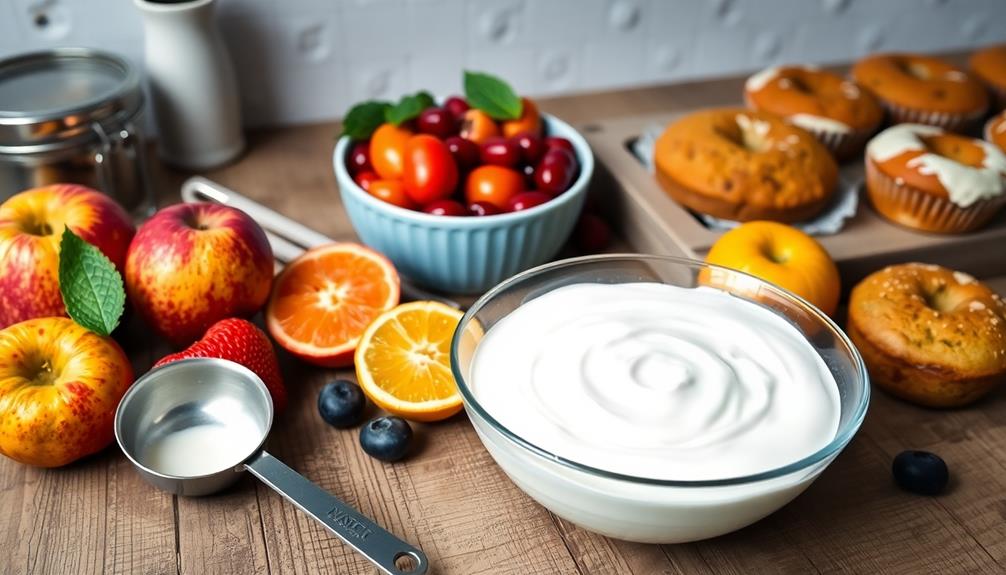
Greek yogurt serves as a versatile alternative to butter in baking, bringing both moisture and creaminess to your recipes. By using Greek yogurt, you can reduce the fat content while still achieving a rich texture.
It works well in a variety of baked goods, from cakes to muffins, enhancing flavor without overpowering it.
Here are some tips to make the most of Greek yogurt in your baking:
- Substitution Ratio: Replace half the butter in your recipe with Greek yogurt for best results.
- Flavor Boost: Consider using flavored Greek yogurt, like vanilla or honey, to add an extra layer of taste.
- Texture Improvement: Combine Greek yogurt with other moist ingredients, like mashed bananas or applesauce, for a softer crumb.
- Health Benefits: Enjoy the added protein and probiotics that Greek yogurt provides, making your treats a bit healthier.
When you're ready to experiment, you'll find that Greek yogurt not only meets your baking needs but elevates your creations.
Give it a try, and enjoy the delicious results!
Silken Tofu
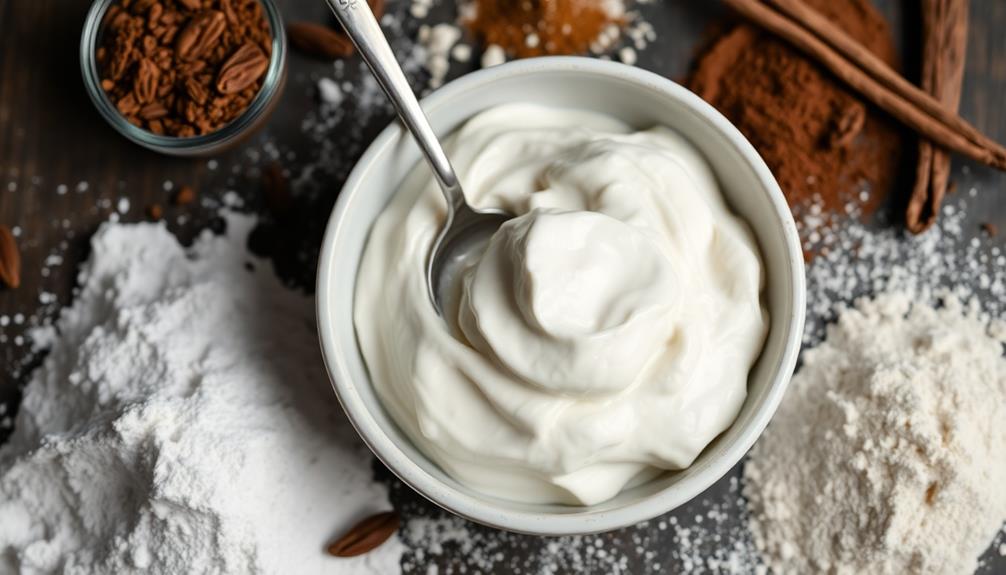
If you're looking for another butter alternative in baking, silken tofu might just be the perfect fit. This versatile ingredient works wonders in various recipes, adding moisture and creaminess without the added fat and calories of butter.
Silken tofu is made from soybeans and has a smooth, custard-like texture, making it ideal for blending into batters. To use silken tofu, simply purée it until it's completely smooth. You can substitute it for butter in a 1:1 ratio, but it's often best to start with a little less and adjust based on your desired texture.
This alternative is particularly effective in dense baked goods like brownies or cakes, where the rich flavor of cocoa can mask any bean taste. One of the biggest benefits of silken tofu is its ability to add protein and nutrients to your baked items.
Plus, it's a fantastic option for vegan bakers or those with dairy allergies. Just remember, while silken tofu can create moist and delicious results, it may not achieve the same buttery flavor. Experiment with spices or extracts to enhance the overall taste of your baked goods!
Margarine
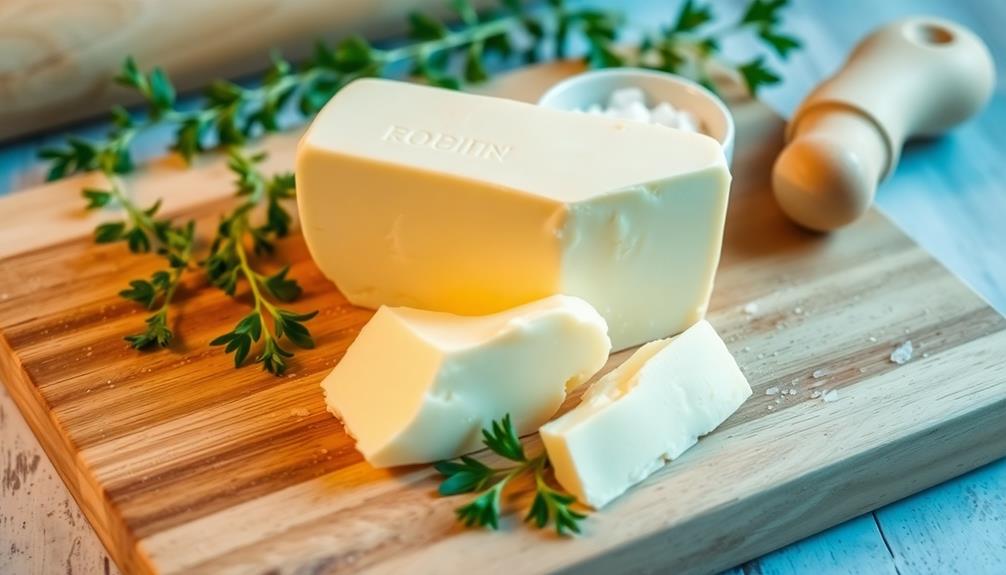
Margarine serves as a popular butter alternative in baking, offering a similar texture and flavor profile at a lower cost.
It's made from vegetable oils and can be a great option for those looking to cut down on saturated fats. When you choose margarine for your baking needs, you'll find it works well in various recipes, enhancing moisture and richness without overpowering other flavors.
Here are some tips to make the most of margarine in your baking:
- Choose the right type: Look for stick margarine for recipes that require solid fat, as it holds up better than spreadable varieties.
- Adjust measurements: Use a 1:1 ratio when substituting margarine for butter, but keep in mind that margarine may have a higher water content.
- Melt it wisely: If a recipe calls for melted butter, melt your margarine gently to avoid separating the fats.
- Check for additives: Some margarines contain additives or trans fats, so read labels carefully to choose a healthier option.
With these tips, you'll be ready to bake delicious treats using margarine confidently!
Ghee

Ghee, a type of clarified butter, stands out as a flavorful alternative for baking that can bring a unique richness to your recipes.
It's made by simmering butter to remove the water content and milk solids, resulting in a golden, nutty product that's lactose-free. This makes ghee an excellent choice for those with lactose sensitivities.
When you use ghee in your baking, you'll notice a deeper flavor profile that enhances cookies, cakes, and pastries. Its high smoke point allows you to bake at higher temperatures without burning, making it versatile for various baking techniques.
You can easily substitute ghee for butter in a 1:1 ratio, but keep in mind that it has a denser texture, so your baked goods might turn out a bit richer.
Additionally, ghee is packed with healthy fats, which can contribute to a moist texture in your baked treats.
Whether you're making brownies or savory breads, incorporating ghee can elevate your baking experience.
Frequently Asked Questions
Can I Use Butter Alternatives in Savory Recipes?
You can use butter alternatives in savory recipes. Just remember to choose options that complement the dish's flavors, like olive oil or coconut oil, and adjust the quantities to maintain the right texture and taste.
How Do Butter Alternatives Affect Baking Texture?
When baking, using butter alternatives can be like dancing with a new partner; it changes the rhythm. You'll notice differences in texture—some may be denser, while others add a delightful lightness to your creations.
Are Butter Alternatives Suitable for Vegan Diets?
Absolutely, butter alternatives fit perfectly into vegan diets. They provide the necessary fats without any animal products. You'll find plenty of options, ensuring your baking remains delicious while aligning with your dietary choices. Enjoy experimenting!
Can I Mix Different Butter Alternatives Together?
Imagine blending colors on a canvas; mixing different butter alternatives can create unique flavors and textures in your baking. Experimenting with combinations often enhances your dishes, so don't hesitate to try mixing them together!
How Do I Measure Butter Alternatives Compared to Butter?
When measuring butter alternatives, use a 1:1 ratio for most substitutes. If you're using something like applesauce or oil, adjust according to their consistency and moisture content. Always check specific guidelines for best results.
Conclusion
In the grand culinary arena, butter alternatives reign supreme, transforming your baking adventures into a symphony of flavor and health. Embrace the velvety embrace of coconut oil or the creamy allure of avocado, and watch as your treats soar to heavenly heights. With each delightful substitution, you're not just baking; you're crafting masterpieces that would make even the most seasoned pastry chef weep tears of joy. So go ahead, release your inner culinary genius and revolutionize your kitchen!
